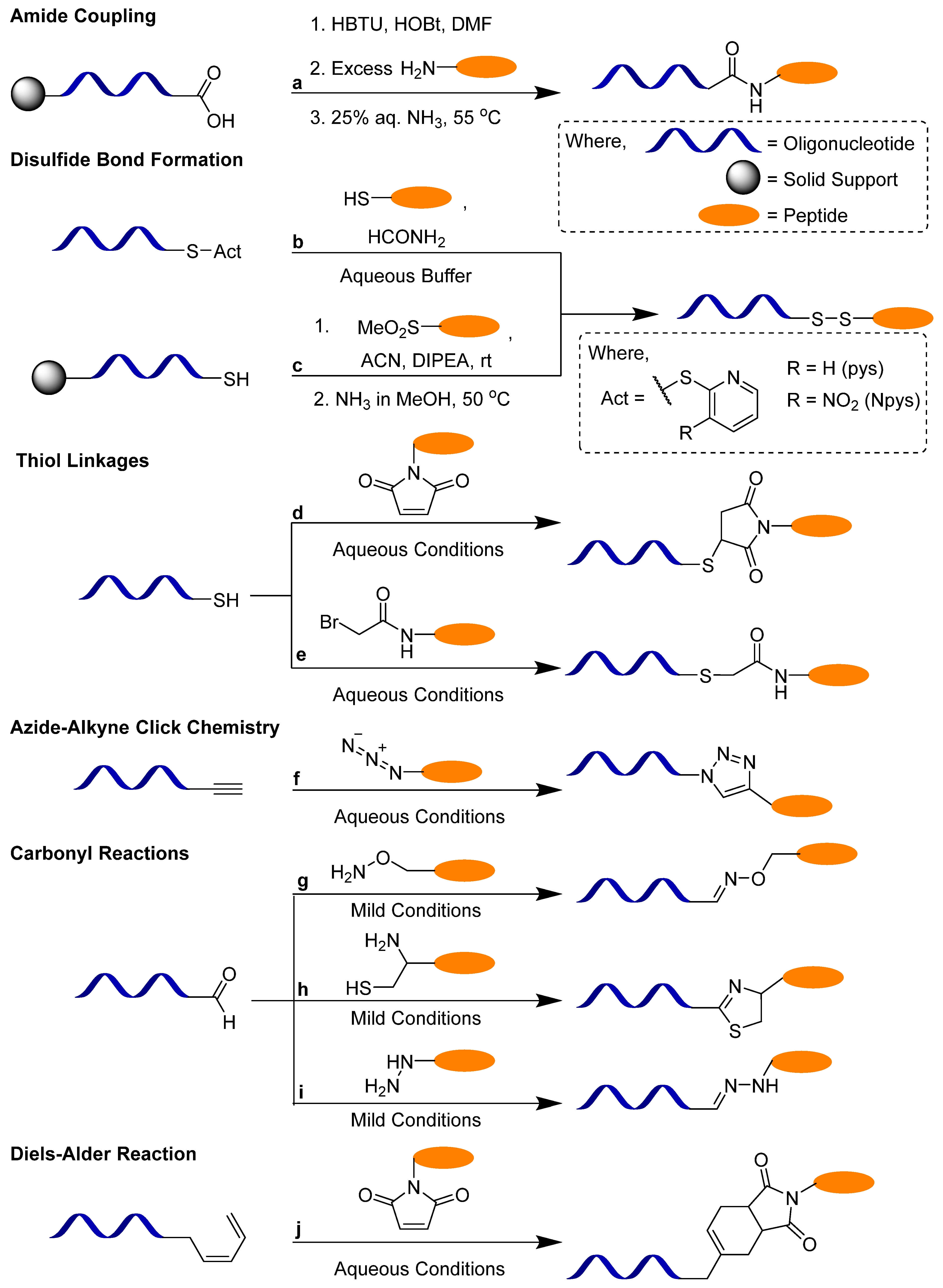Oligonucleotide-Peptide Conjugation Services
Introduction
Creative Biolabs' Oligonucleotide-peptide Conjugation service addresses nucleic acid therapeutic challenges (inefficient delivery, off-target effects, toxicity) via advanced conjugation chemistries and proprietary platforms. It creates custom conjugates, enhancing stability, targeted delivery, cellular uptake, and reducing toxicity, optimizing for efficacy, bioavailability, and minimal off-target interactions.
Discover How We Can Help - Request a Consultation
Oligonucleotide-peptide Conjugation
Oligonucleotide-peptide conjugation covalently links oligonucleotides (short DNA/RNA) to peptides (short amino acid chains). This strategy combines oligonucleotides' gene-modulating ability with peptides' delivery/targeting strengths, creating conjugates that better cross biological barriers, boost cellular entry, resist enzymatic degradation, and accumulate specifically at target sites.
| Peptide Types | Core Role | Features | Examples |
|---|---|---|---|
| Cell-penetrating peptides (CPPs) | Boost oligonucleotide cellular uptake across biological barriers (e.g., membranes) without toxic transfection reagents. | They often carry positive charges or have amphiphilic structures, binding to oligonucleotides through electrostatic interaction or directly interacting with cell membranes. | TAT, Penetratin, R8 |
| Targeting Peptides | Achieve precise delivery of oligonucleotides, specifically bind to the surface receptors of target cells/tissues, and reduce off-target effects. | Sequences are derived from natural ligands or have been screened and optimized to recognize specific biomarkers. | RGD peptide (targeting integrin, used for tumor delivery), NGR peptide (targeting tumor neovascularization) |
| Stability-modified peptide | Protect oligonucleotides from degradation by nucleases and extend their half-life in the body. | It contains special chemical modifications (such as D-amino acids, cyclization structures) or reduces enzyme recognition through steric hindrance. | - |
| Functional peptide | Endow the conjugate with special functions such as controlling release, responding to environmental stimuli, or regulating biological activity. | It can respond to environmental signals such as pH and enzymes. | pH-sensitive peptides (released by degradation in acidic environments), enzyme-responsive peptides (activated by cleavage of tumor-associated proteases) |
Workflow
Synthesis
Creative Biolabs employs advanced strategies to overcome the chemical incompatibilities often encountered when combining oligonucleotide and peptide chemistries. Our primary approaches include:
- Stepwise Solid-Phase Synthesis: Sequentially adds nucleosides/amino acids to a solid support for precise structure control and internal peptide introduction. Minimizes side reactions; challenges with compatible protecting groups.
- Post-Synthetic Conjugation (Click Chemistry): Synthesizes oligonucleotides/peptides separately (with reactive groups like azide/alkyne), then joins via "click" reactions (e.g., copper-catalyzed cycloaddition). >85% yields, can introduce flexible peptide introduction at any linkage.
 Fig.1 Common post-POC synthesis reactions include amide conjugate, disulfide bond formation, thiol-maleimide click chemistry, etc.1
Fig.1 Common post-POC synthesis reactions include amide conjugate, disulfide bond formation, thiol-maleimide click chemistry, etc.1
Purification
After conjugation, rigorous purification removes unreacted materials, side products, and impurities to obtain high-purity oligonucleotide-peptide conjugates. Creative Biolabs uses advanced chromatography, with HPLC as the primary method, employing RP-HPLC and IE-HPLC, optimized for each conjugate's physicochemical properties to isolate the target with exceptional purity, critical for downstream biological use.
Quality Control
- Mass Spectrometry (MS): MALDI-TOF and ESI-MS confirm molecular weight, verifying conjugation success and detecting impurities.
- Analytical HPLC: Measures purity and homogeneity to meet strict quality standards.
- UV-Vis Spectroscopy: Quantifies oligonucleotides and assesses conjugate concentration.
- Melting Temperature (Tm) Analysis: For duplex oligonucleotides, it confirms hybridization properties and stability.
What We Can Offer
Customized Conjugate Design
Experts tailor conjugates to your therapeutic targets and delivery needs for optimal performance.
Enhanced Cellular Uptake & Targeted Delivery
Advanced methods boost oligonucleotide uptake and enable specific delivery, including to extra-hepatic sites.
Superior Stability & Reduced Toxicity
Conjugates resist nucleases, use non-toxic delivery, eliminating cytotoxic transfection reagents.
Flexible Synthesis Capabilities
Versatile approaches allow peptide introduction at any preselected linkage, controlling structure/function.
Support for Clinical Translation
Robust capabilities produce conjugates for preclinical and clinical use, accelerating development.
Custom Mitochondrial Targeting Oligo Synthesis
Custom Mitochondrial Targeting Oligo Synthesis involves engineering oligonucleotides with targeting moieties to enable specific delivery to mitochondria, supporting mitochondrial gene regulation and related research.
Experience the Creative Biolabs Advantage - Get a Quote Today
Customer Reviews

FAQs
Q: How do oligonucleotide-peptide conjugates improve upon traditional oligonucleotide delivery methods?
A: Oligonucleotide-peptide conjugates boost delivery via peptides, aiding cellular uptake and targeting. They enter cells through natural endocytosis (no toxic lipid reagents), reduce cytotoxicity, resist nucleases, and enable precise tissue/cell targeting to minimize off-target effects.
Q: What types of peptides can be conjugated to oligonucleotides?
A: We can conjugate diverse peptides: CPPs for uptake, receptor-targeting peptides (e.g., to tumors/cardiac tissue), and endosomal escape-enhancing peptides. Flexible synthesis accommodates varied sequences for unique project needs.
Q: Can these conjugates be used for in vivo applications?
A: Oligonucleotide-peptide conjugates, with enhanced stability, better uptake, and targeted delivery, suit in vivo therapy. Published data and clinical evaluations show their potential for systemic use and efficacy in preclinical models (e.g., cancer, miRNA inhibition).
Our Oligonucleotide-peptide Conjugation service uses advanced chemistries and platforms to boost oligonucleotide stability, targeted delivery, and uptake, reducing toxicity. Offering stepwise solid-phase and click chemistry methods, with expert support.
Contact Our Team for More Information and to Discuss Your Project.
Reference
- Malinowska, Anna L., Harley L. Huynh, and Sritama Bose. "Peptide–Oligonucleotide Conjugation: Chemistry and Therapeutic Applications." Current Issues in Molecular Biology 46.10 (2024): 11031-11047. DOI: 10.3390/cimb46100655. Distributed under Open Access license CC BY 4.0, without modification.
